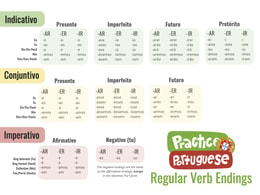With so much to learn about the European Portuguese language, it helps to consider what you’ll actually use most frequently. Let’s start off with the top 10 most common Portuguese verbs!
serto be (permanent)
estarto be (temporary)
terto have
fazerto do, to make
poderto be able to, can
irto go
dizerto say, to tell
haverto have, to exist, to be, to happen
darto give
verto see
To see the list of all 75 common verbs, click here.
These were selected based on analysis of online texts specific to Portugal (i.e. for European Portuguese). Members get access to 100s of verbs and exercises for each verb conjugation.
Examples
Examples give you much more information about the meaning of a verb and how it’s really used, so let’s see an example for the 10 most common:
- ser: É de onde?Where are you from? (sing.,formal)
- estar: Como estás?How are you? (sing.,inf.)

- ter: Eu não tenho um garfoI don't have a fork
- fazer: Eu faço o pãoI make the bread
- poder: Eu posso fazer tudoI can do anything
- ir: Eu vou para casaI go home
- dizer: Eu digo que simI say yes
- haver: Há um elefante na salaThere is an elephant in the room
- dar: Eu dei-lhes a frutaI gave them the fruit
- ver: Eu vejo-as na ruaI see them on the street
Irregular Common Portuguese Verbs
Did you notice that many of the verbs look quite different once you put them in a sentence? Almost half of the most common verbs are irregular, meaning their conjugations don’t follow consistent rules and must be memorized. (Some of these will be regular in certain tenses and irregular in others. Others will be entirely irregular. It just depends on the verb!) You can explore the most common irregular verbs here: Common Irregular Verbs
Regular Common Portuguese Verbs
Luckily, the other half are regular verbs, meaning the endings for each tense are based on consistent rules. Once you know the rules for regular -ar verbs, regular -er verbs, and regular -ir verbs, you can apply them to every other regular verb you encounter, including all of these common regular verbs: Common Regular Verbs
Here’s a handy guide to those regular endings:

Download the Featured PDF for free below
 We hate spam and guarantee you 100% privacy. You can unsubscribe at any time.
We hate spam and guarantee you 100% privacy. You can unsubscribe at any time.You’ll notice in the chart that the tenses are divided into categories based on the 3 “moods”. The indicative mood (indicativo) relates to statements of fact and more concrete topics (e.g. “I am making a cake”). The subjunctive mood (conjuntivo) relates to hypotheticals, such as when you’re talking about hopes or possibilities (e.g. “I would make a cake, if I had time”). The imperative mood (imperativo) is used to give commands (e.g. “Make me a cake, please”).
Want More Verb Practice?
In addition to the verb exercises mentioned above, members can also access the interactive lessons in the following units, which cover a variety of verb tenses and important verbs. (Non-members can access the Learning Notes for free.)
Present Tense (Indicative):
- 👩💻 -AR Verbs 1 👩💻 -AR Verbs 2 👩💻 -AR Verbs 3 👩💻 -AR Verbs 4
- 👩💻 -ER Verbs 👩💻 -IR Verbs
- 👩💻 Common Irregular Verbs
- 👩💻 The Verbs Ser and Estar 👩💻 The Verb Pôr
- 👩💻 Present Continuous
Subjunctive / Conjuntivo:
Other Verb Topics:



..Indicativo….conjunctivo….imperativo…. I am a MD with much difficult words in my vocabulary, but I have to confess that I have no clue what these words mean…it seems everyone learning a language understand these…I remember primary school. at that time I already did not grasp all these ….perhaps a good idea to link these terms to a nice explanation?
Good point, thanks! I added a brief explanation just below the chart to explain the difference between those 3 verb “moods”. I hope that helps! 🙂
This is great. Well done. But why is it that “O aeroporto está próximo do centro da cidade”? Why “está” and not “é” or “fica”?
Eu não acho que o aeroporto vai mudar, entāo não faz sentido.
When it comes to where something is located, especially something large like a building, the verbs ser, estar, and ficar are generally interchangeable. So é or fica would work there too. The temporary/permanent rule is helpful, but unfortunately it doesn’t always apply so strictly. You can read more here:
The Verb Ficar
Ser vs Estar
I like to know languge portuges
I wish to learn Portuguese
Thank you for the list of common verbs. Would suggest also adding “andar and gostar”.
Other verbs that I’ve been encountering quite often as a beginner are: contar, tomar, entrar, regressar, recordar, lembrar, perguntar, pegar, pôr, olhar, assistir (which I just learned also meant “to watch”), ler, sentar, and morar (which I first thought meant “to die” – the complete opposite!)
I’m putting together my index cards with main conjugations (presente, imperfeite, perfeite, conjunctive, futuro) and on the other side, I also have the imperative, gerund and present perfect forms, e.g. Seja! sendo, (ter) sido
Thank you for all your hard work in making this platform so useful, valuable, and most of all, FUN!
Thank YOU for your words!
We do have those two verbs: andar and gostar. On the main menu, under LEARN > VERBS. Search for them on the Search tab and you’ll find them there.
Happy new year!
Very informative but I’ve been learning Duolingo which is Brazilian Portuguese for 168 days, even though I live in the Algarve!!! Am I going to get very confused?
Brazilian Portuguese and European Portuguese sound quite different, so it may be confusing at first, but more listening practice will help you adjust to the pronunciation.
Here’s more information about our program if you’re interested in learning European Portuguese with us. 🙂